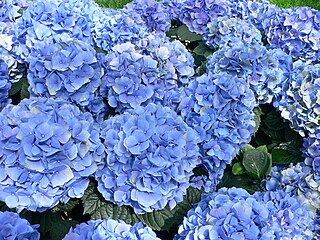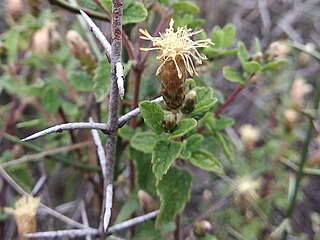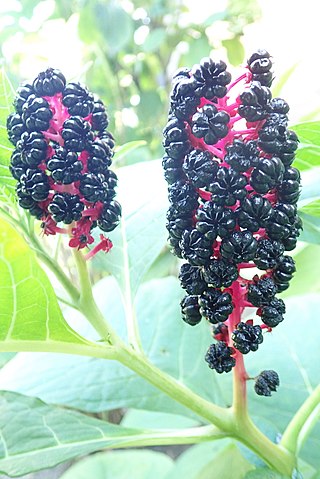
Sida cordifolia is a perennial subshrub of the mallow family Malvaceae native to India. It has naturalized throughout the world, and is considered an invasive weed in Africa, Australia, the southern United States, Hawaiian Islands, New Guinea, and French Polynesia. The specific name, cordifolia, refers to the heart-shaped leaf.

Apigenin (4′,5,7-trihydroxyflavone), found in many plants, is a natural product belonging to the flavone class that is the aglycone of several naturally occurring glycosides. It is a yellow crystalline solid that has been used to dye wool.

Flavones are a class of flavonoids based on the backbone of 2-phenylchromen-4-one (2-phenyl-1-benzopyran-4-one).

Malvin is a naturally occurring chemical of the anthocyanin family.
In enzymology, a flavone synthase (EC 1.14.11.22) is an enzyme that catalyzes the chemical reaction

Baicalein (5,6,7-trihydroxyflavone) is a flavone, a type of flavonoid, originally isolated from the roots of Scutellaria baicalensis and Scutellaria lateriflora. It is also reported in Oroxylum indicum and Thyme. It is the aglycone of baicalin. Baicalein is one of the active ingredients of Sho-Saiko-To, which is a Chinese classic herbal formula, and listed in Japan as Kampo medicine. As a Chinese herbal supplement, it is believed to enhance liver health.

A metalloanthocyanin is a chemical complex giving color to petals of certain plants.

Cynaroside is a flavone, a flavonoid-like chemical compound. It is a 7-O-glucoside of luteolin.

Eupatolitin is a chemical compound. It is an O-methylated flavonol, a type of flavonoid. Eupatolitin can be found in Brickellia veronicaefolia and in Ipomopsis aggregata.

Brickellia veronicifolia is a North American species of plants in the family Asteraceae. It is widespread across much of Mexico, from Chihuahua to Oaxaca. In the United States, it very rare, found only in the Chisos Mountains inside Big Bend National Park in Texas, and also in Otero County in New Mexico.
Flavonolignans are natural phenols composed of a part flavonoid and a part phenylpropane.

Centaureidin is an O-methylated flavonol. It can be isolated from Tanacetum microphyllum, Achillea millefolium, Brickellia veronicaefolia, Bidens pilosa and Polymnia fruticosa.

Isoscutellarein is a flavone found in Cupuaçu and in the liverwort Marchantia berteroana.

Hypolaetin is a flavone. It is the aglycone of hypolaetin 8-glucuronide, a compound found in the liverwort Marchantia berteroana. Hypolaetin 8-glucoside can be found in Sideritis leucantha.

Alnetin is a flavone isolated from Lindera lucida.

Luteolin-7-O-glucuronide is a chemical compound that is classified as a flavone.

Velutin is a chemical compound isolated from Xylosma velutina and açaí fruit. It is classified as a flavone.

Solanum pubescens is a wild shrub found in the foot hill areas of southern India. It is very closely related to the Turkey berry. This shrub does not have spines; leaves are smaller in size covered with dense sticky hairs. Flowers are larger, purple to violet, the flowering and fruiting is seasonal in S. pubescens. Flowering will occur from August to December. The fruits are around 1.2 cm diameter and is more bitter. Matured fruits change in color to orange.

Cannflavins are a group of chemical compounds found in Cannabis sativa. Chemically, they are prenylflavonoids and are unrelated to THC and other cannabinoids. Cannflavins A and B were first identified in the 1980s and cannflavin C was identified in 2008.

Phytolacca acinosa, the Indian pokeweed, is a species of flowering plant in the family Phytolaccaceae. It is native to temperate eastern Asia; the Himalayas, most of China, Vietnam to Japan, and has been widely introduced to Europe. The species was originally described by William Roxburgh in 1814.


















